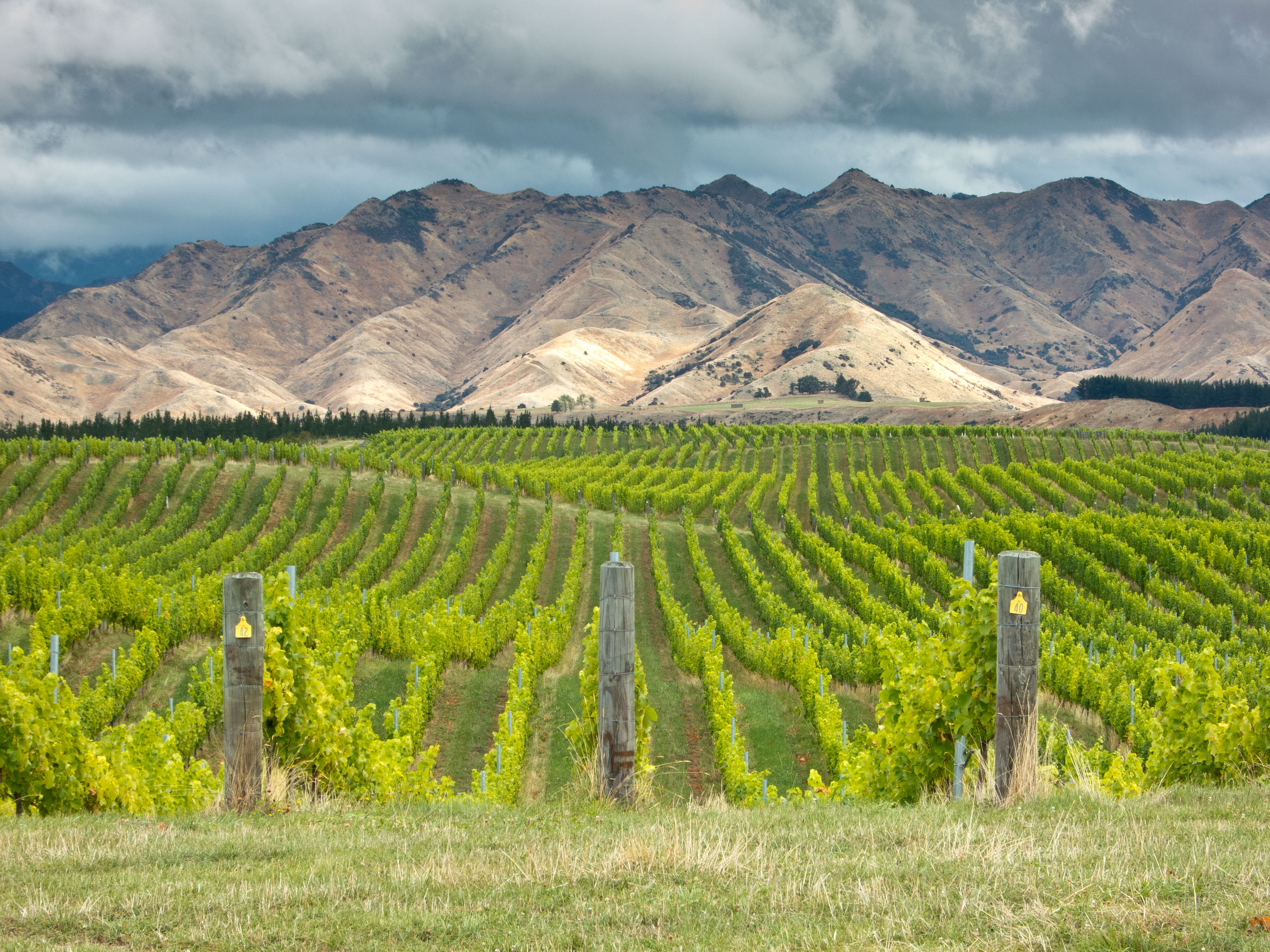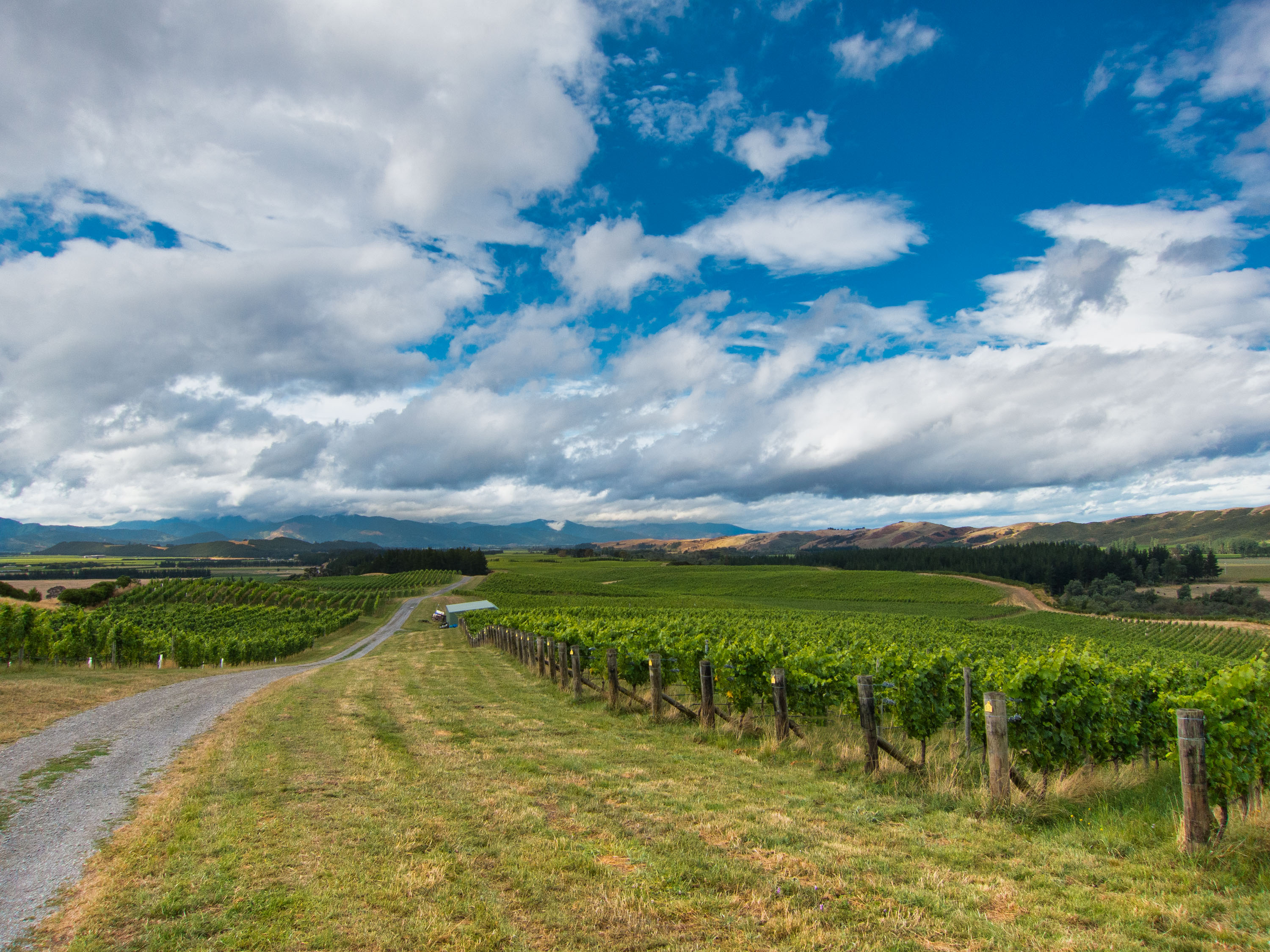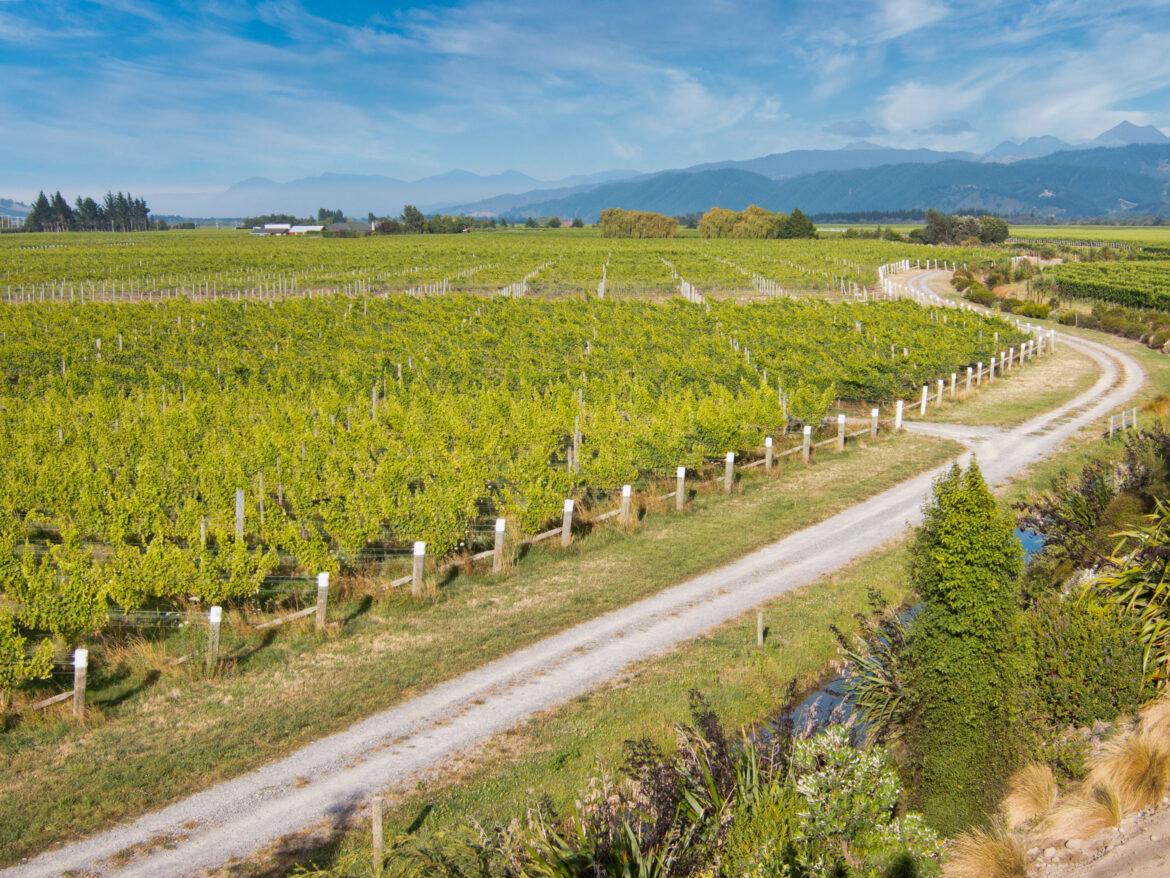I’ve long said that selecting the top 12 wines made in your region each year using a blind tasting run by a third party and then sending that case of wines to commentators around the world is one of the smartest and most compelling bits of regional wine marketing I’ve ever experienced. I’m thrilled to get my Gimblett Gravels collection every year, and now it seems like the folks at Appellation Marlborough are getting into that action, putting together an annual case of 12 Marlborough Sauvignon Blancs representative of the vintage.
The World’s Beloved White Wine
Few wine categories have taken the world by storm like New Zealand Sauvignon Blanc, which burst on the global scene in the 1980s and made its region of origin, Marlborough, one of the best-known wine regions in the world. The words “Marlborough” and “Sauvignon Blanc” have become indelibly linked, as countless drinkers have used those three words to place orders for a predictably delicious glass of wine for decades.
Of course, many people increasingly simply say “New Zealand Sauvignon Blanc” and the folks in Marlborough have been working hard to make sure that people understand that those two phrases are most definitely not the same. There’s a lot of New Zealand Sauvignon Blanc that doesn’t come from Marlborough, but it’s not clear that consumers understand the difference, or care.
To that end, the Appellation Marlborough organization was founded in 2018 with the goal of evangelizing, protecting, and certifying the origin, authenticity, and quality of wines that carry the Marlborough designation. In addition, the organization, which now includes more than 65 producers, has made environmental sustainability a major focus.

 The official Appellation Marlborough wine mapA Unique Terroir
The official Appellation Marlborough wine mapA Unique Terroir
Located at the northeast tip of New Zealand’s South Island, Marlborough wine country consists of a series of wide river valleys carved in amongst several parallel mountain ranges. Blessed by abundant sunlight, consistent breezes off the Cook Strait to reduce frost (at least in the lower reaches), and sufficient rainfall, Marlborough’s expansive valleys are about as easy a place to grow wine grapes as you can find. Combined with the remarkable demand for Sauvignon Blanc around the world, it’s no wonder that the acreage continues to expand at a steady clip.
The largest and most historic of Marlborough’s valleys is the massive Wairau Valley, with its wide, flat opening to Cloudy Bay (the namesake of the wine brand most responsible for Marlborough Sauvignon Blanc’s popularity). Wairau features roughly three distinct soil types: loams and silt loams on the valley floors, with some alluvial clays in a series of smaller side valleys that are collectively known as the Southern Valleys.
Just to the south, over the Blairich Range lies the slightly smaller Awatere Valley. Whenever New Zealand gets around to making sub-appellations (which they will hopefully do at some point) Awatere will merit its own, both for its complex soils that range from loam to sand to gravels and clay, as well as for its much cooler temperatures, especially amongst the vineyards that continue to be planted farther to the west and higher in elevation.


These two sub-regions of Marlborough host the vast majority of the vineyards in New Zealand, somewhere north of 60% of all the planted acres in the country. Plantings are also increasing in the drier, less fertile soils of the Southern Coast region, though these are more likely to include Pinot Noir and Chardonnay than Sauvignon Blanc.
It’s worth noting that Marlborough Pinot Noir has been excellent for a long time, but has a hard time competing (by volume and by sheer popularity) with the juggernaut that is Marlborough Sauvignon Blanc.
Perhaps one day Appellation Marlborough will make a Pinot Noir collection, but for now, they seem to be sticking with Sauvignon Blanc.
Consistent Quality, Diverse Flavors
In addition to showcasing the region more generally, one of the purposes of developing the Appellation Marlborough Collection seems to be to showcase both regional and stylistic diversity within Marlborough. In short, not all Marlborough Sauvignon Blanc tastes the same, both because of different sites on which they are produced, and because producers are increasingly stepping away from what some see as too-formulaic an approach to the region’s winemaking.
The famous flavors of Marlborough Sauvignon Blanc are a product not just of the grape itself and the place that it is grown, but also a set of production methods used by many producers. These methods have evolved over time to produce the signature, stereotypical flavors of Marlborough Sauvignon Blanc—the combination of green apple, gooseberry, passionfruit, and grassy green bell pepper notes that so many have come to love.


These flavors and aromas are primarily the product of certain aromatic compounds known as thiols, and a number of things can influence and heighten their presence in the wine, including the crop loads in the vineyard, machine harvesting (common in the region), the specific selection of yeasts for fermentation, the temperatures at which fermentation occurs, and the fermentation vessel (usually large steel tanks).
These days, some producers are choosing to use different yeasts (or add none at all), ferment partially or wholly in barrels, and may also be experimenting with crop loads and harvesting methods. Combined with differences driven by site-specific factors, there’s more variation than some consumers might imagine amongst Marlborough Sauvignon Blanc.
Even as styles begin to diversify, one thing continues to be true about these wines. They offer consistent and reliable pleasure. Not everyone loves Marlborough Sauvignon Blanc, but for those who do enjoy it, it’s generally pretty difficult to find a bad one—a fact that has, no doubt, played into its massive success around the world.

 The 2024 Collection
The 2024 Collection
The Appellation Marlborough Collection is selected through blind tasting by a panel of wine writers and experts. In the case of the 2024 collection, those judges were Master of Wine Stephen Wong, wine writer and educator Elaine Chukan Brown, and Paul Stringer, the wine category manager at retailer Moore Wilson & Co.
The 2024 vintage was 20-30% smaller than normal in the region thanks to some poor flowering in the Spring due to cold winds, and a significantly drier than normal growing season, with rainfall at a mere 42% of average—the least in many decades. The summer was filled with warm days, and as autumn rolled around in March, cold nights helped preserve the brilliant natural acidity of the wines as well as stave off any real disease pressure, resulting in extremely healthy fruit. A couple of cold snaps resulted in some frost damage in more marginal sites, but otherwise, the growing season was free of trouble. Some winemakers called it the easiest and cleanest harvest of their (very long) careers.

 The 2024 Appellation Marlborough Collection. Image courtesy of Appellation Marlborough.Tasting Notes
The 2024 Appellation Marlborough Collection. Image courtesy of Appellation Marlborough.Tasting Notes
Some of these wines are not currently showing up for sale online in the US, which may mean that they are not imported yet, or are simply not widely distributed. Consequently, I couldn’t determine the price for those wines or offer a link to purchase. In some cases, the 2024 vintage of these wines may not yet be on our shores.


2024 Dog Point Vineyard Sauvignon Blanc, Marlborough, New Zealand
Palest gold in the glass, this wine smells of lemon zest and lemon pith with a hint of struck match. Wonderfully bright and saline notes of green apple, lemon pith, lime zest, and grapefruit have a lovely crisp zing thanks to excellent acidity. There’s also a silky texture here that is quite compelling. Mouthwatering. Whole-bunch pressed, and 85% fermented with ambient yeasts. Aged for 4 months before bottling without fining. 13.5% alcohol. Closed with a screwcap. Score: between 9 and 9.5. Cost: $25. click to buy.
2024 Astrolabe Sauvignon Blanc, Marlborough, New Zealand
Palest gold in the glass, this wine smells of cut grass and green apple. Bright flavors of lime zest, green apple, and a touch of kiwi have a zippy crispness thanks to excellent acidity and the barest whisper of salinity. Machine harvested, destemmed, and pressed. Fermented in stainless steel with “neutral” yeasts. 13.5% alcohol. Closed with a screwcap. Score: between 8.5 and 9. Cost: $20. click to buy.
2024 Starborough “Sons of the Soil” Sauvignon Blanc, Marlborough, New Zealand
Palest greenish gold in the glass, this wine smells of cut grass, passionfruit, and grapefruit. Bright passionfruit and grapefruit flavors mix with lime zest and a hint of salinity. Very good acidity, and a nice stony underbelly, but I’d like perhaps a tiny bit more intensity. Fermented in stainless steel and left on the light lees for 2 months before blending and bottling. 13.5% alcohol. Closed with a screwcap. Score: between 8.5 and 9. Cost: $??
2024 Auntsfield “Nature’s Path” Sauvignon Blanc, Marlborough, New Zealand
Pale greenish gold in color, this wine smells of lemon pith, white flowers, and a hint of passionfruit. Lemon juice and passionfruit mix with white flowers and a nice silky texture, with hints of orange peel in the finish. Very good acidity. Certified organic. Fermented in steel and aged with extended lees contact. 13.5% alcohol. Closed with a screwcap. Score: between 8.5 and 9. Cost: $??
2024 Nautilus Sauvignon Blanc, Marlborough, New Zealand
Light gold in the glass, this wine smells of candied grapefruit and passionfruit with a hint of green apple. Bright green apple, passionfruit, grapefruit, and lime zest have a wonderfully chalky underbelly and a zip thanks to excellent acidity. Long finish. Destemmed, crushed, and pressed directly, and fermented in stainless steel, with 2% barrel fermentation. Left in contact with the lees for 3 months before bottling. 13.5% alcohol. Closed with a screwcap. Score: around 9. Cost: $17. click to buy.
2024 Ahi Kā “Blackmore Vineyard” Sauvignon Blanc, Marlborough, New Zealand
Palest greenish gold in color, this wine smells of passionfruit, guava, green apple, and lime zest. Bright green apple, guava, cut grass, and passionfruit flavors are welded to a lovely wet chalkboard minerality that is quite striking. Crisp and zippy thanks to excellent acidity. Machine harvested and crushed, then pressed. Settled for 24 hours and fermented in steel at low temperature. Matured on light lees for several months before filtering and bottling. 13% alcohol. Closed with a screwcap. Score: between 9 and 9.5. Cost: $??
2024 Pretty Paddock Sauvignon Blanc, Marlborough, New Zealand
Near colorless in the glass, this wine smells of lime zest and green apple skin with a faint herbal note. Grapefruit and lime zest flavors have a positively crackling, mouthwatering acidity, and a wet pavement minerality that lingers for a long time in the finish with lime juice, a touch of passionfruit, and warm hay. 13% alcohol. Closed with a screwcap. Score: between 9 and 9.5. Cost: $??
2024 Isabel Estate “Single Vineyard” Sauvignon Blanc, Marlborough, New Zealand
Pale greenish gold in the glass, this wine smells of lemon pith and white flowers. Crisp lemon and lime pith mix with a touch of white flowers and softer acidity. A short period of skin contact was allowed before fermenting with a variety of yeast strains in stainless steel, with a small part in barrel. 13% alcohol. Closed with a screwcap. Score: around 8.5. Cost: $23. click to buy.


2024 Whitehaven “Block 11 Barrel Fermented” Sauvignon Blanc, Marlborough, New Zealand
Pale greenish gold in color, this wine smells of vanilla, sweet oak, and lemon oil. Lemon and vanilla mix with white flowers, and a hint of salty pastry cream. Very good acidity. A chalky quality lingers in the finish. Whole-bunch pressed into neutral oak puncheons where the wine fermented with ambient yeasts. 80% of the wine went through natural malolactic conversion. 13.5% alcohol. Closed with a screwcap. Score: around 8.5. Cost: $20. click to buy.
2024 Rohe “Blind River” Sauvignon Blanc, Marlborough, New Zealand
Palest greenish gold in color, this wine smells of wet chalkboard, green apple, and green melon. Green apple and green melon flavors are shot through with cut grass and lemongrass, with a hint of lime zest lingering in the finish. Excellent acidity and length. Whole-cluster pressed and fermented in stainless steel with various yeasts and at several different temperatures. Left to age on the lees for 3 months before bottling. 13.5% alcohol. Closed with a screwcap. Score: around 9. Cost: $??
2024 Huia Sauvignon Blanc, Marlborough, New Zealand
Pale greenish gold in color, this wine smells of green gooseberries and green apples. Bright green apple and gooseberry flavors mix with some white flowers and a touch of lime. Crisp and bright thanks to very good acidity. 13.5% alcohol. Closed with a screwcap. Score: around 9. Cost: $22. click to buy.
2024 Georges Michel “Golden Mile” Sauvignon Blanc, Marlborough, New Zealand
Palest gold in the glass, this wine smells of green apple, passionfruit, and honeysuckle. Bright flavors of green apple, honeysuckle, and kiwi have a nice zip to them thanks to excellent acidity. There’s a faint wet chalkboard minerality here too. Fermented in steel and kept on the fine lees for 3 months before bottling. 13.5% alcohol. Closed with a screwcap. Score: between 8.5 and 9. Cost: $22. click to buy.

